Flag of the United Arab Emirates
 From Wikipedia - Reading time: 13 min
From Wikipedia - Reading time: 13 min
 | |
| Use | National flag and ensign |
|---|---|
| Proportion | 1:2 |
| Adopted | 2 December 1971 |
| Design | A horizontal tricolour of green, white and black with a vertical quarter width red bar at the hoist |
| Designed by | Abdulla Mohammed Al Maainah |
The flag of the United Arab Emirates (علم دولة الإمارات العربية المتحدة) contains the Pan-Arab colors red, green, white, and black. It was designed in 1971 by Abdullah Mohammed Al Maainah, who was 19 years old at that time, and was adopted on 2 December 1971 after winning a nationwide flag design contest.[1][2] The main theme of the flag's four colors is the sovereignty and unity of the Arab states.
Merchant ships may fly the alternative civil ensign, a red flag with the national flag in the canton. Emirates Airlines uses the UAE flag as part of their livery.
All seven emirates use the federal flag interchangeably as the flag of the emirate, however, with the exception of Fujairah, all also emirates have separate flags (though some emirates share the same flag).
Design
[edit]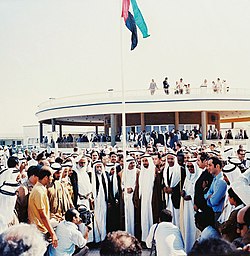

Construction sheet
[edit]
Colors
[edit]| Colors | Green | White | Black | Red | |
|---|---|---|---|---|---|
| Meaning[3] | Plains of the Emirates | The Acts of the Emirates | The Battles and Dark Times of the Emirates | The Emirati Swords | |
| Standard shades[4] | PANTONE | PANTONE® 348 |
n/a |
PANTONE® BLACK |
PANTONE® 186
|
| CMYK | 100/0/100/15 |
0/0/0/0 |
10/0/0/100 |
0/92/77/22
| |
| RGB | 0/115/47 |
255/255/255 |
0/0/0 |
200/16/46
| |
| Hexadecimal | #00843D |
#FFFFFF |
#000000 |
#C8102E
| |
Gallery
[edit]-
Flag of the president of the United Arab Emirates

-
Flag of the president of the United Arab Emirates (1973–2008)

Historical flags
[edit]-
Flag of the Al Qawasim (Sharjah and Ras Al Khaimah) prior to 1820
-
Flag of the Emirate of Kalba (1921–1952)
-
Flag of the Trucial States Council (1968–1971)
Flag of each emirate
[edit]Each of the seven emirates within the United Arab Emirates belonged to either the Hinawi or Ghafiri tribal confederations; both had a red banner representing the Hashemite dynasty and allegiance to the prophet Muhammad. The Qawasim, although part of the Ghafiri, had their own flag (a green, white, and red banner) which used to distinguish them as a maritime power. In 1820, after the British Empire campaign on Ras Al Khaimah, six out of the seven emirates signed the General Maritime Treaty with the British Empire, which compelled them to be under the British Protectorate rule and protection in the region. A white segment was imposed, to be added to each emirate's flag. At the time, Fujairah, not recognized as an emirate by the British and thus not a signatory of the 1820 general treaty, continued to use its plain red flag.[5]
On 6 November 1975, Sheikh Sultan bin Muhammad Al-Qasimi took down the British-imposed flag, the White Pierced Red flag, from Sharjah, stating:
After defeating the Al-Qawasim tribe, the British occupiers gave the Qawasim this flag to replace their own flag, which used to have three horizontal colours: green, white and red from top to bottom, with a Quranic inscription 'A victory from Allah and an imminent conquest' on the white part. The loss of our national flag occurred on Saturday 8 January 1820. So what I have done now is restore dignity to the citizens of Sharjah of today and to the citizens of Sharjah of the past, all of whom have been forced to salute the flag of the very aggressors who had removed our own flag, a flag that had symbolized the struggle of Al-Qawasim.[6]
On 15 November 1975, Ajman, Umm Al Quwain, and Fujairah followed suit and replaced their flags with the federation flag. Soon after, the flags of the other emirates were lowered and the UAE flag was raised.[6]
Abu Dhabi
[edit]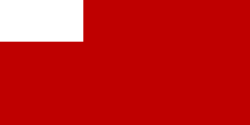
 Flag of Abu Dhabi
Flag of Abu Dhabi
The flag of Abu Dhabi is a red flag with a white rectangle at the top-left corner. According to the 1820 General Maritime Treaty with the British, in times of war a full red flag would be used by the Bani Yas (Abu Dhabi and Dubai).[7] Although per the treaty, Abu Dhabi was supposed to fly the White Pierced Red Trucial States flag, in practice it continued to fly a plain red flag. Percy Cox, the British Colonial Office administrator in the Middle East, was unsuccessful in convincing Zayed bin Khalifa Al Nahyan to adopt the Trucial States flag, which, Zayed argued, represented the Al Qawasim tribal federation.[8] Abu Dhabi later adopted a red flag with a top left white rectangle to distinguish it from the surrounding emirates.
Ajman and Dubai
[edit]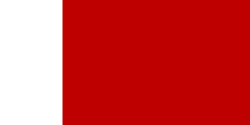
 Flag of Ajman
Flag of Ajman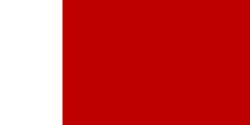
 Flag of Dubai
Flag of Dubai
The flags of Ajman and Dubai are identical. They are both plain red with a white bar at the hoist, i.e. closest to the flag staff.[9] The flag is known as the White Red Halved and was adopted as an alternative to the Sharjah and Ras Al Khaimah White Pierced Red by the Emirate of Dubai and Ajman to distinguish their authority from the Al Qawasim in defiance of the bonds of the 1820 General Maritime Treaty with the British.[10] To the British, this flag was titled as Trucial Coast Flag No.1 and Abu Dhabi and Umm Al Quwain were also expected to adopt it.[11] According to the treaty, in times of war a full red flag would be used by the Bani Yas (Abu Dhabi and Dubai)[7] and a full white flag by Ajman.[12]
The Shihuh of Musandam Peninsula (Ruus Al Jibal) also had a similar flag.[13]
Fujairah
[edit]
 Flag of Fujairah before 1952, and 1961–1975
Flag of Fujairah before 1952, and 1961–1975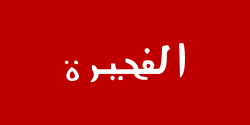
 Flag of Fujairah 1952–1961
Flag of Fujairah 1952–1961
 Fujairah currently uses the national flag of the United Arab Emirates.
Fujairah currently uses the national flag of the United Arab Emirates.Before 1952, the flag of Fujairah was plain red. Fujairah did not sign the general treaty in 1820 with the British and therefore continued using its red plain flag.[5] From 1952 to 1961, the emirate's name was added to the flag, and a red flag with a white Arabic calligraphy of the emirate name (Arabic: الفجيرة, romanized: al-Fujayra) was adopted as an ensign to distinguish it from the surrounding emirates. In 1975, the plain red flag was abolished and the national flag of the United Arab Emirates is now used for official purposes.
Ras Al Khaimah and Sharjah
[edit]
 Flag of Ras Al Khaimah and Sharjah (Al Qawasim) after signing the 1820 General Maritime Treaty with the British Empire
Flag of Ras Al Khaimah and Sharjah (Al Qawasim) after signing the 1820 General Maritime Treaty with the British Empire
The flags of Ras Al Khaimah and Sharjah are identical as they are ruled by two branches of the same house. The flags have a large red rectangle on a white background. The flag, known as the White Pierced Red flag, was the intended flag for all the Trucial States according to the 1820 Maritime Treaty with the British. It was widely attributed to the Al Qawasim tribal federation. Percy Cox, the British Colonial Office administrator in the Middle East, was unsuccessful in convincing the rest of the emirates' Sheikhs to adopt it.[14] To the British, this flag was titled as Trucial Coast Flag No. 2.[11] According to the treaty, in times of war the original Al Qassimi flag (green, white and red flag) was to be used by the Qawasim.[15]
Umm Al Quwain
[edit]
 Flag of Umm Al Quwain
Flag of Umm Al QuwainThe flag of Umm Al Quwain consists of a red background, a white bar at the hoist similar the flags of Ajman and Dubai, and a large white star and crescent in the center, a symbol of Islam representing allegiance to the Islamic world.[9] The Umm Al Quwain flag was supposed to be the same White Red Halved flag as the one used by both Dubai and Ajman, but a star and crescent were added to distinguish it from the other emirates.[11]

See also
[edit]References
[edit]- ^ Farooqui, Mazhar (October 28, 2021). "Meet the Emirati diplomat who designed UAE's flag as a teenager". Khaleej Times. Archived from the original on October 6, 2022. Retrieved November 22, 2023.
- ^ "History of the United Arab Emirates Flag". Flagdom. Archived from the original on 2019-11-03. Retrieved 2019-02-19.
- ^ "THE UNITED ARAB EMIRATES FLAG". www.protocol.dubai.ae. Archived from the original on 30 August 2017. Retrieved 2024-03-08.
- ^ "United Arab Emirates Flag and Official Portraits Guidelines For Federal Entities and Embassies" (PDF). p. 9.
- ^ a b Complete Flags of the World. Smithsonian Handbooks. 2007. p. 184. ISBN 978-0-7566-4115-3.
- ^ a b Al Qassimi, Sultan bin Mohammad (2012). Taking the Reins: The Critical Years, 1971-1977. London: A & C Black Business Information and Development. p. 5. ISBN 9781408181171.
- ^ a b Coll 30/15 'Anthems and Flags of Various States. Bahrein [Bahrain], Koweit [Kuwait], Muscat, Asir, Yemen, Qatar, Trucial, Oman' [61r] (107/261). British Library: India Office Records and Private Papers. 30 March 2017. p. 107. Archived from the original on 12 April 2019. Retrieved 12 April 2019.
{{cite book}}: CS1 maint: publisher location (link) - ^ Coll 30/15 'Anthems and Flags of Various States. Bahrein [Bahrain], Koweit [Kuwait], Muscat, Asir, Yemen, Qatar, Trucial, Oman' [61r] (103/261). British Library: India Office Records and Private Papers. 30 March 2017. p. 103. Archived from the original on 12 April 2019. Retrieved 12 April 2019.
{{cite book}}: CS1 maint: publisher location (link) - ^ a b Hawley, Donald. "The Trucial States". Twayne Publishers, New York, 1970. pp. 326-7.
- ^ Coll 30/15 'Anthems and Flags of Various States. Bahrein [Bahrain], Koweit [Kuwait], Muscat, Asir, Yemen, Qatar, Trucial, Oman' [61r] (151/261). British Library: India Office Records and Private Papers. 21 April 1932. p. 151. Archived from the original on 12 April 2019. Retrieved 12 April 2019.
{{cite book}}: CS1 maint: publisher location (link) - ^ a b c Coll 30/15 'Anthems and Flags of Various States. Bahrein [Bahrain], Koweit [Kuwait], Muscat, Asir, Yemen, Qatar, Trucial, Oman' [61r] (57/261). British Library: India Office Records and Private Papers. 30 March 2017. p. 57. Archived from the original on 12 April 2019. Retrieved 12 April 2019.
{{cite book}}: CS1 maint: publisher location (link) - ^ Coll 30/15 'Anthems and Flags of Various States. Bahrein [Bahrain], Koweit [Kuwait], Muscat, Asir, Yemen, Qatar, Trucial, Oman' [61r] (111/261). British Library: India Office Records and Private Papers. 21 April 1932. p. 111. Archived from the original on 12 April 2019. Retrieved 18 April 2020.
{{cite book}}: CS1 maint: publisher location (link) - ^ Schofield, Richard N.; Blake, Gerald Henry (1988). Arabian Boundaries: Primary Documents. Vol. 26. Archive Editions. p. 450. ISBN 1852071303.
- ^ Coll 30/15 'Anthems and Flags of Various States. Bahrein [Bahrain], Koweit [Kuwait], Muscat, Asir, Yemen, Qatar, Trucial, Oman' [61r] (121/261). British Library: India Office Records and Private Papers. 4 June 1932. p. 121. Archived from the original on 12 April 2019. Retrieved 12 April 2019.
{{cite book}}: CS1 maint: publisher location (link) - ^ Coll 30/15 'Anthems and Flags of Various States. Bahrein [Bahrain], Koweit [Kuwait], Muscat, Asir, Yemen, Qatar, Trucial, Oman' [61r] (113/261). British Library: India Office Records and Private Papers. 30 March 2017. p. 113. Archived from the original on 12 April 2019. Retrieved 12 April 2019.
{{cite book}}: CS1 maint: publisher location (link)
External links
[edit]- Official page for the U.A.E. Flag Day, as hosted by the U.A.E. Ministry of Culture and Youth
- U.A.E. Flag online guide, a website endorsed by the U.A.E. government
- Flag of United Arab Emirates – A Brief History
- United Arab Emirates Flag | All The Details Of Flag[usurped]
- First raising of the flag on 2 December, 1971 (photo)
- United Arab Emirates at Flags of the World
- Interview of the designer of the UAE flag
- Anthems and Flags of the Trucial States in the British Library
- "Flags of the UAE: what do the colours mean?" By James Langton, The National, Nov 3, 2021
 KSF
KSF










